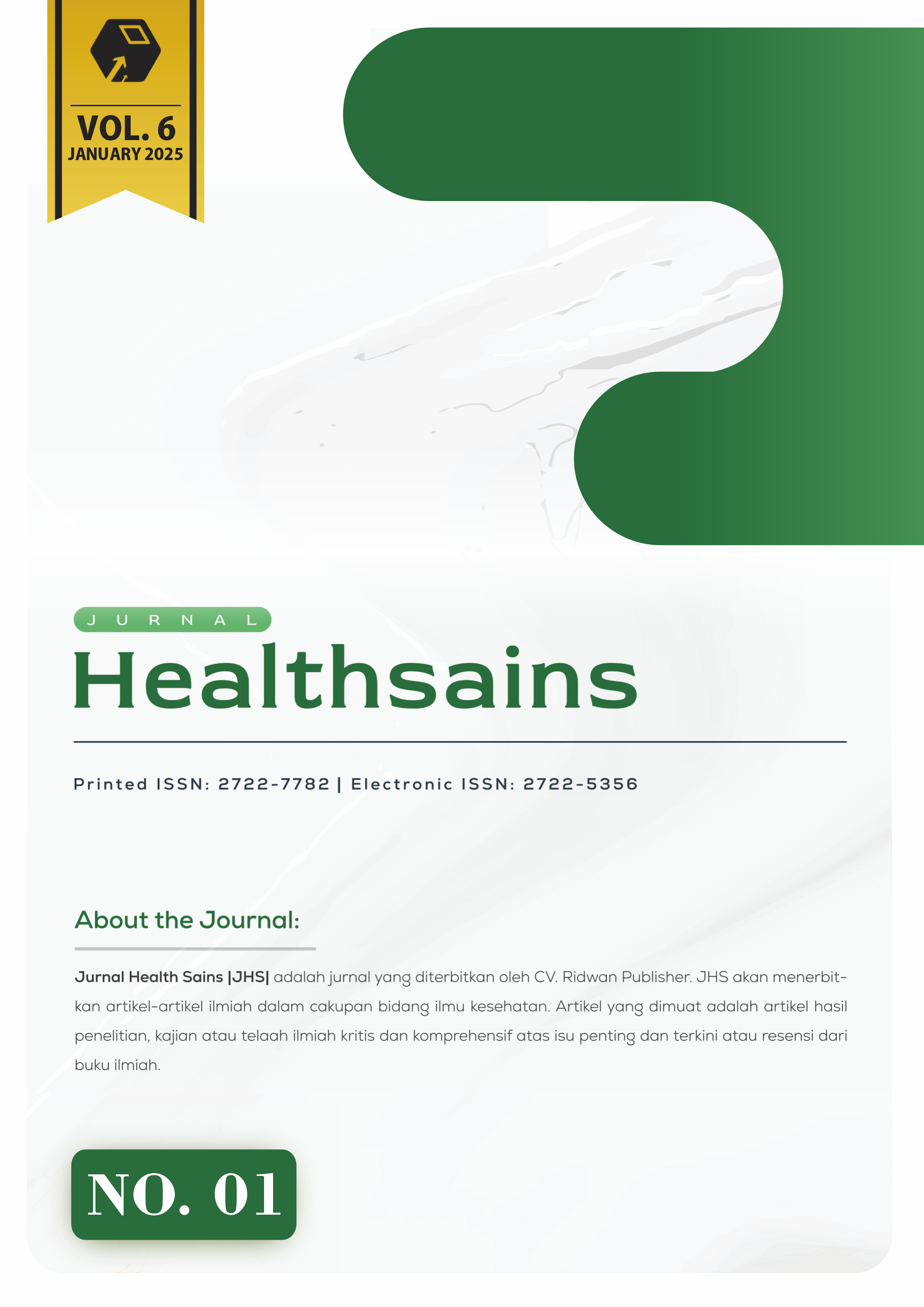Desmoid Tumor Patients Profile in Dr. Soetomo Surabaya Hospital: A Rare Event
DOI:
https://doi.org/10.46799/jhs.v6i1.1462Keywords:
Desmoid tumor, Risk factors, Therapeutic ManagementAbstract
Desmoid tumor (DT) is a fibroblast soft tissue tumor that deep seated connective tissue malignancy developing in musculoaponeurtic tissues. Desmoid tumor is a rare tumor, reported 5-6 cases per million population and account 0.03% of all neoplasm yet the etiopathogenesis of this tumor remains unclear. DT most commonly develops between the age of 15-60 years and common in females, although it rarely metastasized but locally aggressive and affect the adjacent structures. Knowing the profile of desmoid tumor patients at RSUD Dr. Soetomo Surabaya for the period January 2020 – December 2024. Including demographic patients, risk factors, tumor sites, and patients’ managements. All patients between January 2020-December 2024 whose primary DTs were observed. Datas were obtained and observational descriptive study conducted from medical files to record patient’s age, sex, tumor site, and therapeutic managements. All 16 patients were obtained during 5 years with female predominantly (1:4) and adult was more common 19-44 years. Risk factors including in this study were history of trauma, history on pregnancy, and hormonal contraceptive. Location of tumors were found mostly in abdominal wall and the therapy conducted were surgery followed by chemotherapy, and combination of hormonal therapy, TKIs, and radiotherapy. DT is a rare fibroblastic neoplasm that shows locally aggressive behavior with very low incidence annually with female, history of trauma, history of pregnancy, and hormonal contraceptive as a major risk factors. The therapeutic management includes multidisciplinary approach.
References
Alemany, M., Velasco, R., Simó, M., & Bruna, J. (2021). Late effects of cancer treatment: consequences for long-term brain cancer survivors. Neuro-Oncology Practice, 8(1), 18–30.
Antasouras, G., Papadopoulou, S. K., Tolia, M., Pandi, A.-L., Spanoudaki, M., Tsoukalas, N., Tsourouflis, G., Psara, E., Mentzelou, M., & Giaginis, C. (2023). May nutritional status positively affect disease progression and prognosis in patients with esophageal and pharyngeal cancers? A scoping review of the current clinical studies. Medical Sciences, 11(4), 64.
Bektas, M., Bell, T., Khan, S., Tumminello, B., Fernandez, M. M., Heyes, C., & Oton, A. B. (2023). Desmoid tumors: a comprehensive review. Advances in Therapy, 40(9), 3697–3722.
Federman, N. (2022). Molecular pathogenesis of desmoid tumor and the role of γ-secretase inhibition. NPJ Precision Oncology, 6(1), 62.
Figueredo, C., & Schiano, T. (2023). A Review of the Clinical Presentation, Outcomes, and Treatments of Patients Having Desmoid Tumors. Gastro Hep Advances, 2(4), 588–600.
Hendricks, A., Boerner, K., Germer, C.-T., & Wiegering, A. (2021). Desmoplastic small round cell tumors: a review with focus on clinical management and therapeutic options. Cancer Treatment Reviews, 93, 102140.
Liu, J. L., Patel, H. D., Haney, N. M., Epstein, J. I., & Partin, A. W. (2021). Advances in the selection of patients with prostate cancer for active surveillance. Nature Reviews Urology, 18(4), 197–208.
Mangla, A., Agarwal, N., & Schwartz, G. (2024). Desmoid tumors: current perspective and treatment. Current Treatment Options in Oncology, 25(2), 161–175.
Mastoraki, A., Schizas, D., Vassiliu, S., Saliaris, K., Giagkos, G.-C., Theochari, M., Vergadis, C., Tolia, M., Vassiliu, P., & Felekouras, E. (2022). Evaluation of diagnostic algorithm and therapeutic interventions for intra-abdominal desmoid tumors. Surgical Oncology, 41, 101724.
Mona, C. E., Benz, M. R., Hikmat, F., Grogan, T. R., Lueckerath, K., Razmaria, A., Riahi, R., Slavik, R., Girgis, M. D., & Carlucci, G. (2022). Correlation of 68Ga-FAPi-46 PET biodistribution with FAP expression by immunohistochemistry in patients with solid cancers: interim analysis of a prospective translational exploratory study. Journal of Nuclear Medicine, 63(7), 1021–1026.
Riedel, R. F., & Agulnik, M. (2022). Evolving strategies for management of desmoid tumor. Cancer, 128(16), 3027–3040.
Soerjomataram, I., & Bray, F. (2021). Planning for tomorrow: global cancer incidence and the role of prevention 2020–2070. Nature Reviews Clinical Oncology, 18(10), 663–672.
Spolverato, G., Capelli, G., Kasper, B., & Gounder, M. (2022). Management of Desmoid tumors. Surgical Oncology Clinics, 31(3), 447–458.
Sun, Y., Huang, Q., Cui, S., Wang, M., Zhang, N., Zhang, S., Yang, B., Qiu, E., Huang, Z., & Zhou, B. (2021). Outcomes and Quality-of-Life Measures after Endoscopic Endonasal Resection of Kadish Stage C Olfactory Neuroblastomas. World Neurosurgery, 151, e58–e67.
Testa, S., Bui, N. Q., Charville, G. W., Avedian, R. S., Steffner, R., Ghanouni, P., Mohler, D. G., & Ganjoo, K. N. (2022). Management of patients with newly diagnosed desmoid tumors in a first-line setting. Cancers, 14(16), 3907.
Zubor, P., Henriksen, C. M., Økstad, M. E., Cerskuviene, E., Visnovsky, J., Kajo, K., Valkov, A., & Lind, K. O. (2024). Desmoid Fibromatosis of the Anterior Abdominal Wall in Pregnancy: A Case Report and Review of the Literature. Diseases, 12(1), 27.
Downloads
Published
Issue
Section
License
Copyright (c) 2025 Beatta Meidini Rahmat, Edwin Danardono, Asdi Wihandono

This work is licensed under a Creative Commons Attribution-ShareAlike 4.0 International License.
Authors who publish with this journal agree to the following terms:
- Authors retain copyright and grant the journal right of first publication with the work simultaneously licensed under aCreative Commons Attribution-ShareAlike 4.0 International (CC-BY-SA). that allows others to share the work with an acknowledgement of the work's authorship and initial publication in this journal.
- Authors are able to enter into separate, additional contractual arrangements for the non-exclusive distribution of the journal's published version of the work (e.g., post it to an institutional repository or publish it in a book), with an acknowledgement of its initial publication in this journal.
- Authors are permitted and encouraged to post their work online (e.g., in institutional repositories or on their website) prior to and during the submission process, as it can lead to productive exchanges, as well as earlier and greater citation of published work.






